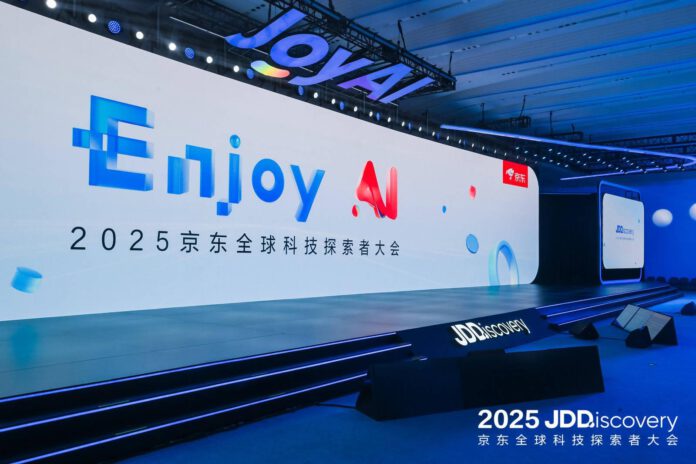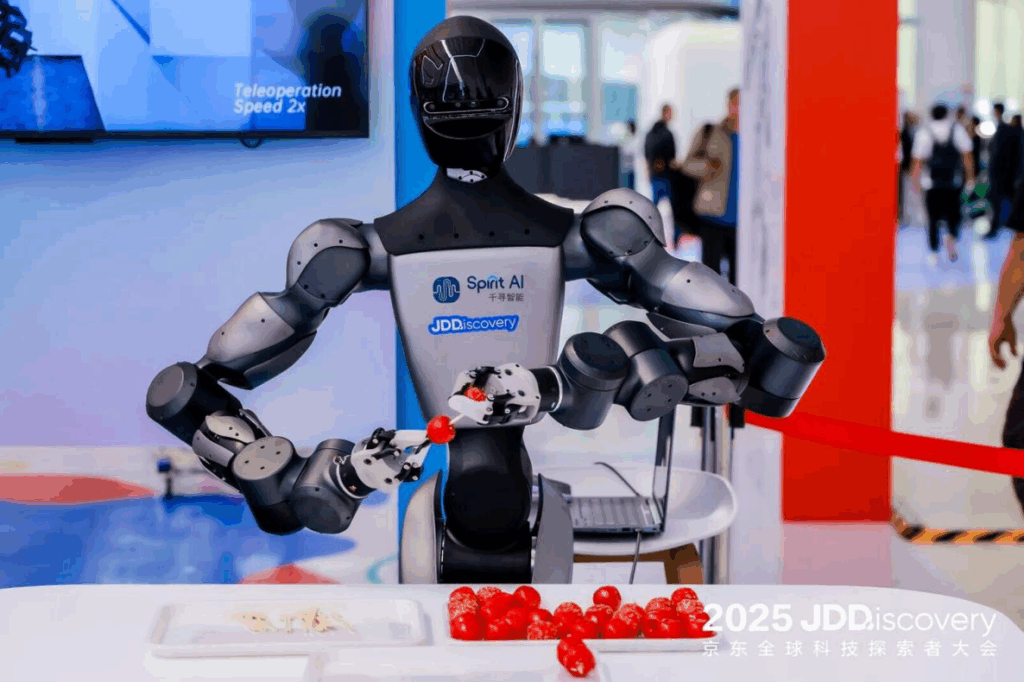
From foundational large models to deep vertical applications, JD.com has demonstrated its determination to make artificial intelligence a central pillar of its long-term strategy. On 25 September, the JD Discovery-2025 JD.com Global Technology Explorer Conference was held in Beijing under the theme “Enjoy AI.” At the event, JD laid out its AI Panorama—an overarching strategic blueprint for its AI efforts—while also announcing that it would continue investing heavily in AI over the next three years to build a trillion-yuan-scale AI ecosystem across multiple industries.
Xu Ran, Vice Chairman and CEO of JD.com, emphasized during his keynote address that the company would not pursue what he termed “campaign-style AI,” focused on hype or one-off showcases. Instead, JD aims to build sustainable AI that generates tangible industrial value. He revisited a formula first introduced at the 2023 JDD Conference—”the value of large models = algorithms × computing power × data × the square of industrial depth”—and noted that through two years of active application and experimentation, this formula had evolved into a more grounded expression: “AI Value = Model × Experience × Industrial Depth².” This refinement highlights JD’s growing focus not just on technical capacity, but on meaningful deployment in industry-specific scenarios.
JD’s perspective comes at a time when global technology giants are making massive investments into AI infrastructure. In their most recent financial reports, Alphabet, Microsoft, Meta, and Amazon revealed that their combined capital expenditure this year has already exceeded $170 billion—most of it poured into AI data centers. Annual spending by these companies is projected to surpass $350 billion by the end of the year. Against this backdrop, JD.com’s decision to double down on AI investment reflects not only competitive urgency but a belief that the AI industry has entered a new phase: from a “parameter race” defined by model size, to an “implementation race” focused on value creation through scenario-based applications.

JD’s response to this transition is built on technological advancement, practical experience, and industrial integration. At the model level, JD’s updated JoyAI model suite now covers a full spectrum from small-scale 3-billion parameter models to 750-billion parameter giants. It has also developed specialized models such as JoyAI LiveTTS for voice synthesis and JoyAI LiveHuman for digital human avatars. Behind these models are algorithmic innovations including Thought Chain Synthesis and Autonomous Planning (AOT), Progressive Self-Play Hybrid Thinking (PST), and Homomorphic Variational Inference Reinforcement Learning (HVRL), which are designed to significantly improve reasoning capabilities, inference efficiency, and engineering performance.
In addition to raw model development, JD has upgraded three core AI platforms that support practical applications across its business units. The Digital Human Platform 4.0 introduced the industry’s first virtual brand ambassador, drastically reducing the cost of livestreaming—by as much as 90% compared to human hosts. The JoyAgent 3.0 platform has been fully open-sourced, and over 30,000 agents are already active across JD’s internal operations. JoyCode 2.0 integrates intelligent agents into development workflows, cutting product development time by nearly a third. These platforms signal JD’s shift away from theoretical AI and toward deployable systems with measurable outcomes.
Rather than follow a purely open-source or academic path, JD’s AI strategy centers on first building capabilities within its own proprietary systems—particularly retail, logistics, healthcare, and industrial supply chains—and then gradually opening those capabilities to partners. The newly released Jingxi App, for example, is a next-generation lifestyle portal that enables users to shop, book travel, and order meals using only voice commands. JD’s new AI assistant “He, She, It” allows users to create and personalize their own intelligent agents and even embed them into smart devices. JD also launched JoyInside, the industry’s first smart integration platform that is now compatible with products from over 30 major hardware brands and is working with more than 10 robotics firms.
In practical deployment, JD unveiled the Logistics Superbrain Model 2.0, which incorporates multimodal learning for real-time logistics optimization. Its e-commerce architecture Oxygen AI—publicly introduced for the first time—is designed to operate intelligent agents across various retail functions. In healthcare, Jingyi Qianxun 2.0 is now capable of interpreting medical records and natural-language patient descriptions. For industrial applications, JoyIndustrial functions as the first large model specifically developed for industrial supply chain optimization, combining big data and AI to significantly improve productivity and reduce operational costs.
JD’s unique competitive advantage lies in the synergy between its technological capabilities and its deep operational infrastructure, especially its supply chain network. At the conference, JD announced that it would begin to open portions of its operational data—including warehousing, sorting, delivery, and pharmaceutical logistics—to external partners in AI and robotics. These high-quality datasets and business scenarios, combined with JD Cloud’s infrastructure, aim to support the training of production-grade models and embodied intelligence systems.
JD’s overarching strategy is clearly moving from internal development to public deployment, and from technical exploration to production-ready applications. In doing so, it is aiming to secure not only technological leadership but also long-term business value through increased user engagement and monetization. With the AI industry entering a phase of scenario-based competition, JD’s approach—grounded in real business use cases and backed by a complex, vertically integrated supply chain—may allow it to build defensible advantages that extend beyond algorithmic performance.
While many firms are still navigating the transition from AI research to business execution, JD appears to be building an AI ecosystem that prioritizes value creation, operational reliability, and industrial relevance. Its formula may be unconventional, but its logic is increasingly compelling: in the next phase of AI, success won’t be determined solely by model size or compute budget, but by how effectively these capabilities are applied to real-world problems at scale. JD’s commitment to industrial depth and pragmatic deployment may be what sets it apart in the next stage of global AI development.
Source: Sina, Xinhua, Guancha, geekpark



